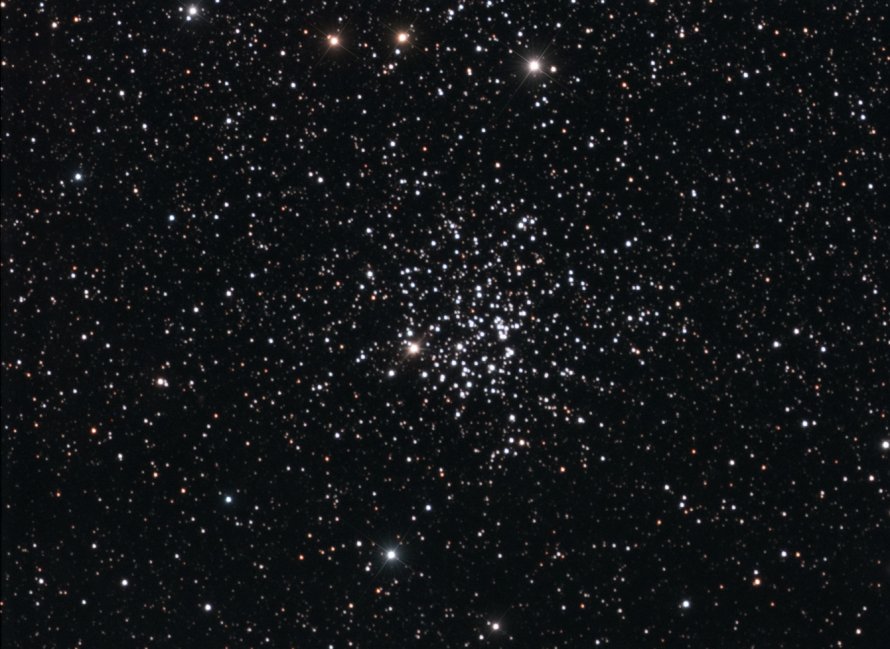M52 (NGC 7654)
Messier 52 (NGC 7654) is an open cluster located in the constellation Cassiopeia, in the Perseus Arm of the Milky Way Galaxy in the Local Group of galaxies. M52 is 4600 light years away from Earth.
M52 is best viewed during winter, is magnitude 6.9, and can be viewed with binoculars. M52 is 13' in apparent size. For reference, the full moon is 30'.
Observing difficulty: Intermediate
- Name:
- Type:
- open cluster
- Constellation:
- Cassiopeia
- NGC or IC:
- NGC 7654
- Magnitude:
- 6.9
- Viewing:
- binoculars
- Size:
- 13'
- Distance (light years):
- 4600 LY
- RA:
- 23h 24.2m
- Dec:
- 61 35'
- Season:
- winter
- Milky Way location:
- Perseus Arm
- Galaxy group:
- Local Group
- Messier Marathon #:
- 7
* The naked eye can see up to magnitude ~7-8 objects under ideal dark sky conditions.
A Window into the Rich Star Fields of Cassiopeia
The Messier Catalogue, a selection of 110 deep-sky objects compiled by French astronomer Charles Messier, has captivated stargazers for centuries. Among these celestial gems is Messier 52 (M52), a splendid open cluster located in the constellation of Cassiopeia. This article provides a comprehensive exploration of M52, detailing its scientific relevance, features, magnitude, and tips on how best to observe it.
Historical Background
First discovered by Charles Messier in 1774, M52 is an open star cluster, a gathering of stars that emerged from the same gas and dust cloud. Over the years, M52 has served as a vibrant research topic, contributing to our understanding of stellar formation and evolution.
Astrophysical Characteristics
M52 lies at a distance of around 5,000 light-years from Earth. It is believed to be around 35 million years old, relatively young in astronomical terms. The cluster spans approximately 19 light years across and is home to over 200 stars, with the brightest members being hot, young, and blue. It is estimated to have a mass roughly 1,300 times that of our Sun.
The cluster contains many variable stars ? stars that vary in brightness over time. Among these are slowly pulsating B-type stars, which are high-mass stars that oscillate over periods of approximately one day. These stars provide critical insights into the internal structure and physics of high-mass stars.
Magnitude and Size
M52 has an apparent magnitude of 7.3, putting it beyond naked-eye visibility but well within reach of a pair of binoculars or a small telescope. It spans around 13 arcminutes across the sky, which equates to less than half the diameter of the full Moon. Despite its size, M52's relative brightness and high star concentration make it a rewarding target for amateur astronomers.
Scientific Importance
Open clusters like M52 are vital to our understanding of stellar evolution. Because all stars in an open cluster form from the same nebula, they share a common age and chemical composition but differ in mass. This allows astronomers to test theoretical models of stellar evolution. The presence of variable stars within M52 also offers an opportunity to study these intriguing objects in detail.
Finding and Observing M52
M52 resides in the constellation of Cassiopeia, known for its distinctive 'W' shape. More specifically, it's found near Cassiopeia's second magnitude star Beta Cassiopeiae, or Caph. Despite being a northern hemisphere object, its high declination means it can also be seen from many southern hemisphere locations.
Under a dark sky, M52 can be spotted with a pair of binoculars as a fuzzy patch of light. A small telescope will resolve individual stars, primarily towards the cluster's outer edges. With larger telescopes, many more stars become visible, and the cluster's rich, compact core can be appreciated.



